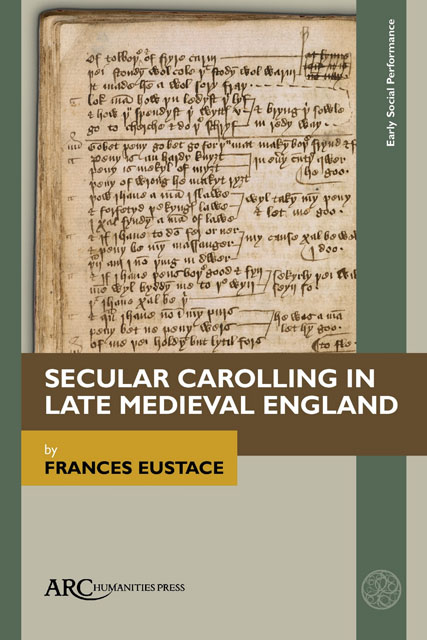Book contents
- Frontmatter
- Contents
- List of Illustrations
- Preface
- Introduction
- Chapter 1 Carolling and Dance-Song in the Context of a Primarily Oral Culture
- Chapter 2 Courtly Carolling: Contexts and Practices
- Chapter 3 The Church, Carolling, and the Emergence of the English Franciscan Carole Writers of The Fourteenth and Fifteenth Centuries
- Chapter 4 Carole Texts in Context: The Manuscripts
- Chapter 5 Carole Texts as Witnesses to Carolling Practice
- Chapter 6 Survivances Of Carolling In Folk Culture
- Conclusion: Carolling from a Dance Movement Psychotherapy Perspective
- Bibliography
- Index
Chapter 3 - The Church, Carolling, and the Emergence of the English Franciscan Carole Writers of The Fourteenth and Fifteenth Centuries
Published online by Cambridge University Press: 06 April 2023
- Frontmatter
- Contents
- List of Illustrations
- Preface
- Introduction
- Chapter 1 Carolling and Dance-Song in the Context of a Primarily Oral Culture
- Chapter 2 Courtly Carolling: Contexts and Practices
- Chapter 3 The Church, Carolling, and the Emergence of the English Franciscan Carole Writers of The Fourteenth and Fifteenth Centuries
- Chapter 4 Carole Texts in Context: The Manuscripts
- Chapter 5 Carole Texts as Witnesses to Carolling Practice
- Chapter 6 Survivances Of Carolling In Folk Culture
- Conclusion: Carolling from a Dance Movement Psychotherapy Perspective
- Bibliography
- Index
Summary
IT IS ALWAYS dangerous to take the views of single witnesses as representative of a majority, yet that is how the understanding that the medieval Church was opposed to dancing in general and carolling in particular has been perpetuated. So let us review the evidence for when and where carolling was considered appropriate in medieval culture and examine the English Franciscans’ adoption of the carole genres of dance-song and lullaby in their song writing.
Vernacular song as an expression of piety and praise dates back to the very beginning of Franciscan practice in the Canticle of the Sun (Cantico delle creature) a hymn said to have been composed by St. Francis himself, ca. 1225. The lauda (pl. laude) a kind of strophic and devotional song in the vernacular was at the centre of Italian Franciscan devotion in non-liturgical contexts. In England, the Franciscans were particularly influential in the development of the carole, both religious and secular, and their approach to carolling is an important element in establishing the practice’s place in society.
Early Franciscan writers reflected a negative attitude to somatic manifestations of music, according with other evidence from ecclesiastical sources that has fostered prejudicial, often anti-feminist, readings by both medieval and modern commentators. However, the work of the Franciscans in the fifteenth century, in the heart of the community, led them to connect with the culture of the people, and dance, and dance-song, was for both men and women a fundamental part of entertainment culture. If ecclesiastical disapproval had been universal, it is difficult to understand how the carole became so embedded in fifteenth-century insular Franciscan culture that they adopted the dance-song and lullaby idioms, thus laying the foundation in England for the seasonal hymns that have been popular since the sixteenth century. In short, carolling was not universally condemned throughout the late Middle Ages and the inevitable association, by clerics, of carolling with a sinful life and the deflowering of virgins has been interpreted selectively by modern writers. Many of the condemnations were specific to particular times and places: the church or churchyard during services and on other occasions, such as during Sunday afternoon sermons, when the sacred and the secular competed directly for the people’s attention.
- Type
- Chapter
- Information
- Secular Carolling in Late Medieval England , pp. 35 - 48Publisher: Amsterdam University PressPrint publication year: 2022



